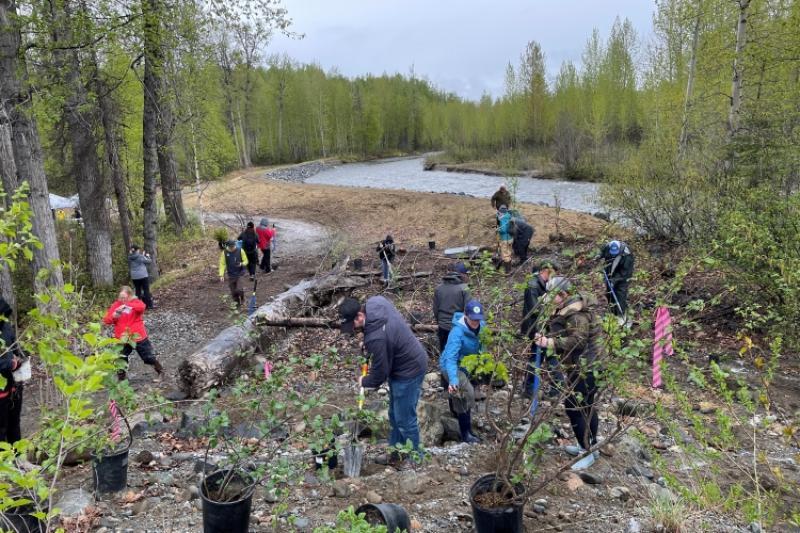
Restoring coral and stream banks through the National Fish Habitat Partnership
by NOAA Fisheries 22 Jun 2024 21:51 UTC

Near Talkeetna, Alaska, volunteers are hard at work planting native trees and shrubs to improve shoreline habitat for fish on Montana Creek, a popular trout and salmon-fishing stream © Trout Unlimited Alaska
In 2023, NOAA Fisheries funded several projects to restore habitat through the coastal National Fish Habitat Partnerships. Since then, partners have made considerable progress on this work, actively engaging local communities—including anglers—to make critical contributions to fish habitat conservation nationwide.
The projects demonstrate NOAA's commitment to restoring fish habitat and supporting access to sustainable saltwater recreational fishing, a popular pastime that boosts the U.S. economy.
Community-Based Coral Restoration in West Oahu, Hawai'i
Sponsoring Partnership: Hawai'i Fish Habitat Partnership
Over the past year, Kuleana Coral Restoration held and participated in numerous events centered around the importance of coral reef habitat and restoration for healthy oceans. They hosted three hands-on events and several outreach booths in West O'ahu, reaching more than 800 people. Attendees created or learned about the use of coral modules—composed of concrete and finger coral (Porites compressa) fragments—for fish habitat restoration. Additionally, the project team participated in a 3-day community event at Poka'i Bay Beach Park called Ho'akea Mauka to Makai, coordinated with Malama Learning Center and Polynesian Voyaging Society. Over 3 days, the event reached 400 students and others who live, fish, and recreate in the area. This work helped inspire students, school staff, and the larger West O'ahu community to become the next leaders in environmental stewardship.
Finally, through community input via dive surveys, Kuleana Coral Restoration also produced two baseline maps of the coral sites to be restored. These maps include both control and coral planting areas, and are used to assess project progress via coral cover estimates.
In addition to this project, see more information on NOAA’s restoration work with Kuleana Coral Restoration and the local community through the Bipartisan Infrastructure Law and Inflation Reduction Act.
Restoring Stream Banks with Anglers in Alaska
Sponsoring Partnerships: Kenai Peninsula Fish Habitat Partnership and Matanuska-Susitna Basin Salmon Habitat Partnership
Trout Unlimited Southcentral Alaska Chapter and partners hosted Plants for Salmon, a community riparian planting day in June 2023. This was the first phase of a collaborative project to restore vegetation and improve salmon habitat along Montana Creek (a tributary of the Susitna River) near Talkeetna, Alaska. More than 60 volunteers—including youth—planted roughly 200 native trees and shrubs, while the Knik Tribe cooked frybread for the volunteers.
Trout Unlimited is currently working with partners to add topsoil and complete additional seeding for sections of exposed rip rap. This will further stabilize the banks of this popular salmon-fishing river. A second planting day, planned this year, will continue improving 450 feet of habitat along these sections of Montana Creek.
This project was also made possible by the Susitna River Coalition, the U.S. Fish and Wildlife Service, Alaska Department of Fish and Game, and the Mat-Su Borough.
Restoration and Angler Outreach near Juneau, Alaska
Sponsoring Partnership: Southeast Alaska Fish Habitat Partnership
With the help of 28 volunteers, Trout Unlimited repaired a remote trail bridge used by hikers, bikers, trail runners, and anglers. This allows them to access Montana Creek (a tributary of the Mendenhall River) in September 2023. Project partners and volunteers re-vegetated the eroded stream banks by planting trees, shrubs, and native grasses. This increased the stability of the stream bank habitat and reduced future erosion.
In addition to plantings, Trout Unlimited re-routed an angler access trail that has caused erosion and reduced water quality. They also developed a set of five signs, placed along the creek. The signs include a map with angler access points, a history of Montana Creek with a focus on local indigenous peoples, and an outline of the project benefits and reduction of downstream impacts. Finally, a QR code placed on temporary signs at fishing access sites will allow anglers to complete surveys to collect information about favored access points and recreational fishing efforts. The surveys will inform future trail planning and improvements.